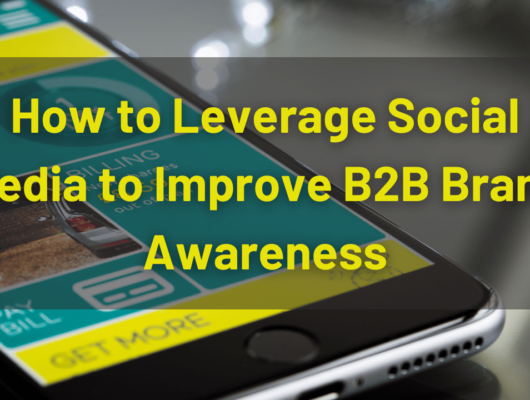What is a Digital Marketing Strategy?
Digital marketing is the use of social media channels, websites and emails to reach your ideal customer. It makes effective use of targeting to reach your target audience.
A digital marketing strategy is the process of streamlining the whole process. A strategy enables you to reach your business goals, achieve measurable outcomes and optimize your budget.
As a B2B business owner, a digital marketing strategy is of prime importance for bringing in new leads, increase brand awareness and generate revenue.
The following article discusses in detail about developing a digital marketing strategy and how you can tailor it for your own business.
Jump to Section:
Key Advantages of a Digital Marketing Strategy
Steps to Create a Digital Marketing Plan from Scratch
Different Types of Digital Marketing Channels
How to Tailor a Custom Strategy for your Business
Key Advantages of a Digital Marketing Strategy
Digital marketing offers expansive benefits for your business such as exposure, increased sales, meeting business targets and much more.
Compared to traditional marketing techniques, digital marketing is cost effective, demands less effort and can potentially reach a much larger diversified audience.
B2B businesses can value greatly from an optimized digital marketing strategy, especially with regards to generating leads, building trust and reducing churn rate.
See how digital marketing can improve your business:
Increase your website traffic and Generate more Leads
Digital marketing can be quite beneficial for online stores, or if your business model is based on provision of services such as consultancy, legal advice or SaaS. B2B companies can also benefit, as most of them do not have a consumer-based storefront.
You can increase traffic to your website through various digital marketing strategies. When people come to the site, they are there for a reason. Whether they are looking for information about your products, searching how to get in touch with your team, or reading the latest posts on your blog.
The more visitors you bring to your business site, through SEO, content marketing, or email marketing, the more opportunities you will have to educate prospects about what you offer. Especially, for a B2B company this means more leads, conversions, and sales.
Increase Brand Awareness and Build Trust
Digital marketing is an excellent tool for creating brand awareness for your business. B2B companies and businesses that sell services can showcase your services or products in a much better way as compared to traditional marketing.
Digital marketing campaigns can reach potentially thousands to millions in a short amount of time. You can create online awareness for your business through search results, their email inbox, a social media platform, or some other medium. As a result, more people are exposed to your brand. They learn about your branding, products, and what sets you apart from competitors. Then, when they need a product or service that you offer, they are more likely to remember your brand and buy.
Improve Lead Quality
One of the most lucrative things about digital marketing is its ability to target individuals that may be genuinely interested in your product or services. Moreover, you lose less revenue as compared to traditional marketing tactics and you reach the right audience. This can mean more leads, better quality leads and increase in clients. Lead quality is important for B2B businesses as their revenue large depends on finding eligible leads and converting them into clients.
Increase your sales
The biggest, most important goal of any marketing strategy is increased revenue. By improving your targeted audiences visits to your site and social media pages you are likely to increase sales for your business. This is especially important for B2B companies, who need to balance marketing investment and sales revenue. A marketing strategy can greatly help in this aspect.
Engage your Current Customers and Reduce Churn Rate
Through digital marketing campaigns you can re-target existing customers or keep in touch with them through email. These practices can lower your churn rate and the customers would be happy with the continuous support and interaction that they receive. Reducing churn rate will ensure that you have returning customers and they may even refer new clients to your business.
Do you want a custom digital marketing strategy that increases awareness and brings in more leads? Call us today to know your options.
Free Scorecard ‒ Get Personalized Marketing Strategy Advice (with actionable tips) in 5 minutes.
Steps to Create a Digital Marketing Strategy
1. Market Research
Begin your marketing strategy by doing a thorough research on current trends, and content that attracts your audience. You can also do some research on your competitors, for example what kind of Ads they are creating or the type of content they are producing.
2. Create a Brand Identity
Draft an outline or use your existing branding guideline to determine your brand identity. See how your brand identity will be represented in your online campaigns. Think of your brand voice, unique selling points (USPs), and value proposition.
3. Perform a S.W.O.T Analysis
S.W.O.T analysis forms the basis for any marketing strategy, so it is applicable to digital marketing as well. S.W.O.T is the acronym for Strengths, Weaknesses, Opportunities, and Threats.
- Strengths include an organization’s strong points that help achieve, and surpass, their goals. Examples of strengths may include higher sales and profits, customer loyalty, long-term employees, or an appealing brand/culture.
- Weaknesses are opposite of strengths and potentially hinder businesses from reaching their goals. Examples of weaknesses may include mismarketing products or services, frequent customer complaints, a high rate of turnover, insufficient financing, or supply chain inefficiencies.
- Opportunities are external positive factors that can help a business succeed in the future. Examples of opportunities may include changing outlook, a new business deal, revised laws or legislation, or the lowering of tariffs/sanctions.
- Threats represent potential external, negative situations that could hurt the organization in the future. Examples of threats could include changes to the labour market, increased cost of supplies, or new competitors/technology.
S.W.O.T analysis is helpful in identifying weaknesses and strengths, so that they can be supported with marketing communication campaigns. If a company’s strength is in fast delivery and high-quality product (but expensive products) then the marketing must focus on highlighting the benefits and strengths of the company and its products, over its competitors.
4. Create S.M.A.R.T Goals
It stands for specific, measurable, achievable, realistic, and timely (S.M.A.R.T) goals. Think about the short-term and long-term goals of your organization to grow. Although used in traditional marketing, this technique is also helpful in developing a digital marketing strategy.
Establishing S.M.A.R.T goals can enable a business to streamline their marketing strategy to deliver profitable results.
You can establish your S.M.A.R.T business goals by following these steps:
- Specific: to your business goals and what is going to be required.
- Measurable: marketing goals should be measurable such as ROI or acquiring more leads.
- Attainable: the marketing goals should be based on the available budget and constraints in place.
- Relevant: keep in mind the prevailing business realities and overall environment to make your end goals valuable.
- Timely: your timeline should be realistic and based on the outcomes and how you will achieve them.
5. Create Effective Market Segmentation
Market segmentation is an integral part of a successful digital marketing strategy. This technique involves breaking down your business’s target market or audience into smaller groups. The practice of breaking down the whole customer base into manageable pieces, unique marketing tactics can be tailored more precisely for each segment of the market.
You can divide your target audience on the following general criteria:
- Demographic: Demographic segmentation occurs within a business-to-consumer (B2C) context, focusing on individual characteristics. Demographic segmentation uses factors like age, education, gender, or geography to break customers down into categories.
- Firmographic: Firmographic segmentation occurs within a business-to-business (B2B) environment, focusing on organizational characteristics. Firmographic segmentation looks at factors like revenues, industry, location, or employee count in order to break down firms into categories.
- Psychographic: Psychographic segmentation may take place either in B2C or B2B settings. Psychographic segmentation looks at factors like opinions, personality, or lifestyle or goals in order to break down prospects into categories.
- Behavioural: Behavioural segmentation may take place in both B2C and B2B settings. Behavioural segmentation looks at factors like brand loyalty, purchasing histories, or usage patterns in order to break down prospects into categories.
An example of marketing segmentation would be mid-level professionals, aged (38-45), living in New York, working for SaaS companies.
6. Develop Buyer Personas
Marketing segmentation and buyer personas go hand-in-hand when developing a digital marketing strategy. Buyer personas are fictional profiles symbolizing an ideal customer. Buyer personas are especially useful in understanding your customers whether they are potential, existing, or desired. Also, buyer personas differ widely by industry and by organization.
Combining buyer personas with a marketing segmentation initiative is common practice among marketers. Through this technique, marketers seek to build profiles of ideal customers from data such as demographics, firmographics, behaviour, and psychographics.
So, to summarize, you need to determine the audience you want to attract through a buyer persona. Think about the users’ demographics like age range and geographic location. Also focus on what motivates people to choose your business, products, and services.
Buyer personas are especially important when it comes to B2B companies, as it helps them create a different buyer journey for each profile.
Want to know what your buyer personas would look like? Book a call with us today to discuss your options.
7. Choose the right Digital Marketing Strategy
Choose a strategy that is best suited to your business type. Focus on techniques that provide the greatest value to your business and industry, not on trendy strategies. We will go into detail how to make a custom digital marketing strategy in later sections of this article.
8. Set a Budget and allocate to each Channel
This is a big segment of your digital marketing strategy, and it can be deciding factor for the success of your marketing strategy. So, to put it in simple words, you need to allocate sufficient funds for digital marketing so that the strategy you designed is executed properly and gives desired results.
9. Execute your Marketing Campaign
Following up on your plan, launch your campaign on all channels that you have selected (social media and search engine ads). Make sure that the tracking information is present on all of your channels. Your website, for instance, should include your Google Analytics tracking code.
10. Gather Analytics Data
Monitor progress of your strategies by tracking their progress and reach. Use Google tools such as Google Analytics, Google Search Console, and Google Ads to monitor the pulse of your strategies and their return on investment (ROI).
Different Types of Digital Marketing Channels
There are several digital marketing channels that you can use, and they are usually tailored to fit different organization’s business goals and marketing strategies.
They generally revolve around the following goals: brand awareness, lead generation, growth, targeting new industries, markets and new product launch. Below is a list for selected marketing channels that support different types of strategies:
Prospecting Campaigns
Prospecting campaigns are a great strategy to create awareness for your brand through online channels. This strategy works well with businesses new to digital marketing. Alternatively, these type of campaigns are great for increasing sales, more website visits and informing clients about promotions.
Depending on your business type, prospecting campaigns can be tailored to fit your business type and goal. Usually, prospecting campaigns are designed as Pay Per Click Ads (PPC). PPC Advertising is a subset of digital advertising in which companies run ads on third-party websites or social media platforms in order to generate traffic to an online site. But unlike other forms of advertising, you only pay for PPC ads only if the user clicks a link.
Social Media Marketing (SMM)
SMM is the practice of using social media networks to target customers and convey company messages. SMM usually involves different ad campaigns that run on social media websites or apps. The social media platform you choose depends on your business type and marketing strategy.
SMM offers excellent reach since the ads are effectively able to reach the target audience. There are different campaign types that you can choose from, for example: awareness, engagement or conversion.
Search engine optimization (SEO)
SEO refers to the practice of optimizing content so that you rank better on the top search engines. Established SEO best practices enable your business to reach potential customers through search engines. The process of SEO begins when you create your website and includes optimizing your static content and frequently updating dynamic content (like blogs) to better rank on search engines. SEO also includes making your website indexable and fast loading.
SEO is a much slower process as compared to SMM, but it makes a great difference in the longer run. It is a great option for B2B companies to rank higher and improve their brand visibility.
Website Marketing
This is a type of content marketing where an organization uses its website as a powerful tool. You can create optimized landing pages and guide prospective leads to your website through paid ads. This type of marketing usually requires effective call to action (CTA) for best results.
Your goal is to grab the attention of website visitors with your products and offerings. If website visitors subscribe to your mailing list, then it is an added plus. This strategy is mostly used by B2B companies as it generates more leads, helps in lead scoring and awareness.
Email marketing
Used to promote engagement with current or prospective audiences or grow client relationships. Well-crafted email marketing campaigns have the power to create loyal customers and keep your followers up to date with your business and its services/products.
You can make email marketing interesting for you clients by sending offers, discounts, or announcements through them. Email marketing is important for B2B companies as it helps the leads down the sales funnel and eventually they can make a buying decision.
Display Ads
Display ads refer to putting a business’s advertisements on a variety of online venues, including search engines and social media networks. Paid placements within search results and pop-up ads are examples of digital advertising.
Display Ads are great for B2C or SaaS companies, as their customers can make a quick decision for purchasing when they are shown these ads. Most display ads run like traditional advertisements.
Downloadable content or lead magnet
A subset of site strategies, downloads offer a powerful method for prospecting. Companies can create quality content for prospects to download for free, providing valuable contact information in the process. This strategy works well for B2B companies as it means more quality leads and awareness.
Blogs
Blogs can serve two purposes in terms of digital marketing. They can increase the online visibility of your business on social media and increase your credibility, build trust. Secondly, they play a huge role in SEO and well researched articles can improve your search engine rankings.
Video Content
Video content has gained a lot of traction since the last 2-3 years. Video content includes YouTube videos, Instagram Reels and even content uploaded to TikTok. Video content has the power to potentially reach millions of viewers if they find value in what you produce. Video content can also be used in paid SMM campaigns.
Very recently, LinkedIn has also started to promote more video content. Take this as a sign if you own a B2B business, that generating video content can greatly benefit your business.
Confused about which channel is best for your B2B business? We can help you with a customized marketing strategy, click here to book a call today.
How to Tailor a Custom Strategy for your Business
There are several factors that go into a tailored marketing strategy for your business. Typically, they include your business type, customer journey and social media platforms suitable for your business.
Business Type
When developing a strategy, your business type plays a vital role. The most common business types are, B2B and B2C models. Industry also plays a role in your strategy, for example if you sell services, your strategy would be more website visits or urging leads to book a meeting with you.
Business Goals
Business goals are crucial in defining your digital marketing strategy. Ask yourself these questions: Do I want more leads? Do I want more people to know about my business? Is lead generation important for getting more sales? Your strategy would depend on these factors.
Buyer’s Journey
This is how you can tailor your business strategy at each step of the buyers journey:
- Awareness: Your prospects realize a problem and start searching to better understand it.
- Interest: They have defined their problems and are looking for available solutions.
- Decision: They find a few solutions and are ready to choose one of them.
- Action: They finally choose one.
The real challenge is to deliver relevant content to your prospects that are in the four different stages of the buyer’s journey – you want to meet each one of their pain points and needs. The type of content you should be creating depends on where your prospects are in the buyer’s journey.
At the awareness stage, your audience needs to identify and better understand their problems. So, you should be creating blog posts or any form of educational content. Likewise, at the decision stage, you can come up with more brand-specific content. But there is no hard and fast rule as to what type of content you need to create for each stage of the buyer’s journey. Your goal is to move your prospects from one step in the sales funnel to another.
Social Media Platforms
Social media platforms play a crucial role in defining your digital marketing strategy. It all depends on where your customers are. Platforms suitable for B2B business type are LinkedIn, Twitter and Company Website. This is because most professionals are on LinkedIn and Twitter, hence you can target them better in these platforms. Best platforms to market for B2C companies are Facebook, Instagram, YouTube, Twitter and TikTok. The reason is because consumers are usually present on these platforms and these platforms allow you to showcase your products well. There are also opportunities to execute influencer marketing for your products.
How Business type, business goals, buyers’ journey and budget come together for Customized Digital Marketing Strategies:
How all factors (budget, business type, buyers’ journey, and business goals) come together to create the perfect strategy for your business are discussed in the following paragraphs.
The components of a perfect digital marketing strategy may vary widely among organizations. This is because company specific marketing goals will reflect differences, usually based on culture, product offerings, revenue goals, and so forth. Aligning different marketing strategies and tactics to the businesses goals and segmented customer personas, makes it possible for businesses of all shapes and sizes to reap the benefits of digital marketing.
The outcomes of any marketing campaign can differ mainly due to the budget and resources available. For start-ups and smaller businesses, a digital marketing strategy usually focuses on low-cost tactics that achieve an organization’s goals.
These organizations may use SEO, SMM, and content marketing with a lower budget to achieve their digital marketing goals. The lower barriers to entry and costs of digital marketing allow organizations of all sizes to benefit.
As businesses grow, their marketing and advertising budgets often increase proportionally. As such, the potential benefits of effective marketing tactics may grow exponentially with the overlapping of marketing, advertising, and PR/investor relations campaigns. Add it all up, and organizations who devote a substantial amount of budget and resources to digital marketing could see a huge payoff.
Conclusion
Digital marketing has become indispensable, and you should seriously consider it as an effective tool to reach more customers and increase sales. Digital marketing is more affordable, requires less effort, and has the ability to reach a much wider variety of audiences than traditional marketing strategies. You can employ a variety of digital marketing methods, and these are typically modified to match the marketing and business objectives of various organizations. A customized marketing plan for your company is based on a number of variables. Typically, they cover your business’s industry, buyers’ journey, and social media channels that are appropriate for it.
Digital Marketing is becoming a competitive field, with the added burden of technicality every passing day. Most businesses are not able to keep up with the current trends or platform specific changes. Contact us today for a well-rounded customized digital marketing strategy for your business.









